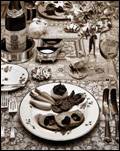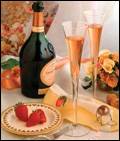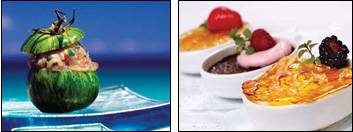The Saliva Factor: Let s Cook Up Some Food Photos
The Saliva Factor: Let's Cook Up Some Food Photos!The job of a food photographer is to elicit the same mouth-watering reaction as the smell of freshly baked bread or the taste of a perfectly grilled steak. A great food photograph can convey feelings of warmth, awaken fond memories, conjure up fantasies, or just plain make you hungry. It can send crowds flocking to a new restaurant or boost the sales of a food magazine. Capturing that perfect image requires a creative eye, finesse, a sense of style, and photographic skill. In the old days, food photographers almost always shot from overhead because that was the way people were used to seeing their foodlooking down on the plate. These photographs were rigid in nature, with utensils and props placed in the positions at which they were traditionally found on the table. Large-format view cameras were used to capture all the details. Because photographers used hot tungsten lights for illumination, the food spoiled and melted quickly! Much of the photography was in black-and-white because most publications and books were printed that way. As time passed, we began to see changes in lighting and mood. Warm and romantic lighting was in vogue for quite some time, though the pictures were still shot primarily from overhead angles. The style was "the more props and accessories, the better." Later, slightly lower angles and a simple Spartan look became the trend, with a bit of earthiness and softness. Even so, the pictures looked staged. I have been there and done all that! My career began in 1975, shooting for The New York Times. I photographed food in black-and-white, and making it look appetizing was what I did best. I did it in spite of the poor reproduction of newsprint. My subsequent experience shooting for magazines, public relations firms, advertising agencies, restaurants and cooking schools, cookbook authors, and chefs has been invaluable in understanding changes in food photography. Having made the switch from film to digital more than 10 years ago, I was ahead of the technological curve. I learned very early that digital technology gives the photographer the opportunity to review shots instantly, make appropriate adjustments, and achieve superior results. Today, a simple, clean, fresh, natural, and light approach is the trend in food photography. We see the imperfections in the food, along with the use of selective focus, tilted plates, and extreme close-ups with fewer props. These techniques have become the industry standard. At the same time, there has been a marked increase in the need for high quality digital food photographyin packaging, advertising, cookbooks, and the Internet. A complete understanding of basic principles is essential in any genre of photographybe it sports, fashion, product, or food. My goal is to help you develop your own recipe for success in food photography. To that end, this book examines studio and location shooting, lighting, composition, food and prop styling, retouching, and much more. Along the way, you'll learn how digital photography combines teamwork, creativity, and technology. With this book, I want to show you how to make money doing something you love. Oh, by the way, eating the end result is a big plus! |




